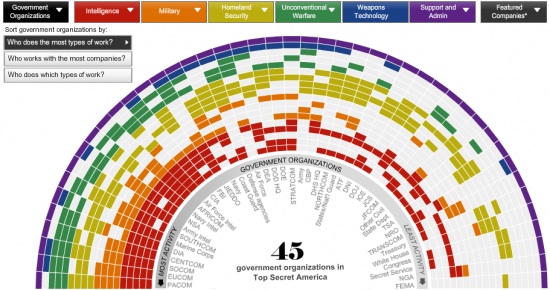20 Jul WaPo unmasks a hidden, top-secret America
The blogosphere is agog at a Washington Post series that uncovers the astonishing, bloated, secret, and likely ineffective national security apparatus that has grown up in the United States following 9/11. Two crack WaPo reporters, Dana Priest and William M. Arkin, spent two years tracking down the story, an increasingly rare example of what the dead-tree media can do when it taps its traditional strengths. Here’s the opening sentence:
The top-secret world the government created in response to the terrorist attacks of Sept. 11, 2001, has become so large, so unwieldy and so secretive that no one knows how much money it costs, how many people it employs, how many programs exist within it or exactly how many agencies do the same work.
Some highlights:
— Some 1,271 government organizations and 1,931 private companies work on Top Secret programs related to counter-terrorism, homeland security, and intelligence at over 10,000 locations across the country. Over 850,000 Americans have Top Secret clearances.
— Redundancy and overlap are major problems and a symptom of the ongoing lack of coordination between agencies.
— In the Washington area alone, 33 building complexes for Top Secret work are under construction or have been built since September 2001.
Andrew Sullivan rounds up blogger reaction. Money quote to Glenn Greenwald:
We chirp endlessly about the Congress, the White House, the Supreme Court, the Democrats and Republicans, but this is the Real U.S. Government: functioning in total darkness, beyond elections and parties, so secret, vast and powerful that it evades the control or knowledge of any one person or even any organization.
Flowingdata highlights the infographic:
Click the image (or here) to activate the graphic and explore that the Post calls, “an alternative geography of the United States, a Top Secret America hidden from public view and lacking in thorough oversight.” [Note: the graphic was sluggish this morning, presumably owing to heavy traffic.]
After nine years of unprecedented spending and growth, the result is that the system put in place to keep the United States safe is so massive that its effectiveness is impossible to determine…
Every day, collection systems at the National Security Agency intercept and store 1.7 billion e-mails, phone calls and other types of communications….
The NSA sorts a fraction of those into 70 separate databases. The same problem bedevils every other intelligence agency, none of which have enough analysts and translators for all this work.
9/11 happened not because intelligence agencies hadn’t detected elements the plot, but because inter-agency secrecy meant no one could put the pieces together. A core finding of the WaPo investigation is that this inability to connect the dots is worse than ever. They detail how various agencies collected ample evidence about alleged Ft. Hood shooter Nidal Hassan and attempted Christmas Day bomber Umar Abdulmutallab, but didn’t recognize its significance.
PBS even has a “making of” video:

